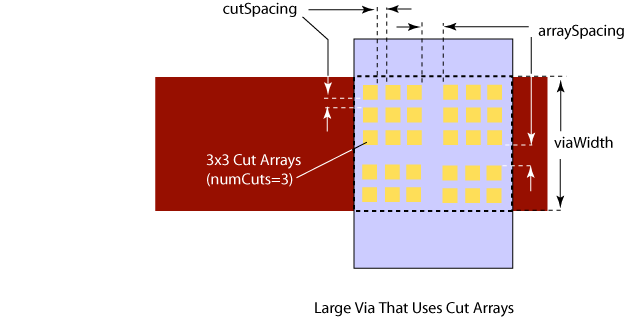 |
 |
 |
||||||
The built-in layer constraint, oacMinLargeViaArrayWidth, specifies the conditions under which via arrays must be built with the spacing specified in oacMinLargeViaArraySpacing. This occurs when a via meets or exceeds the via width specified by this constraint, based on the width of the intersection of the two metal wires that are connected by the cut layer. If this constraint is not specified, the via array to via array spacing specified by oacMinLargeViaArraySpacing constraint is followed when a via array is built.
| Constraint type: | oaLayerConstraint |
| Value types: | oaIntValue |
| Database types: | oaDesign, oaTech |
| Object types: | oaAppObject |
The following value types are supported by this constraint:
oacMinLargeViaArrayWidth has an oaIntValue of type oaWidthLengthTableTypeEnum that specifies the minimum width of the intersection of two metal layers that requires the large via array.
Units: DBU
The following parameters are supported by this constraint:
| Name | Value Type | Units | Default | Description |
|---|---|---|---|---|
| cutClass oacCutClassConstraintParamType |
oaDualIntValue | DBU | None |
This parameter specifies the width and length dimensions of the cut class. |
| parallelOverlap oacParallelOverlapConstraintParamType |
oaBooleanValue | Boolean | False |
If set to true, this parameter specifies that the rule applies only if the cut arrays have non-zero parallel overlap. |

For some processes, vias that exceed a given width must be implemented as sets of cut arrays with specified dimensions and spacings between each array for oxide cuts.
Copyright 2002 - 2010 Cadence Design Systems, Inc.
All rights reserved.